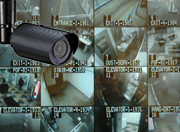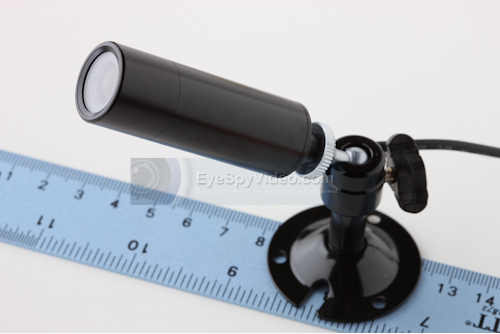Choosing a Lens
CHOOSING THE RIGHT LENS FOR YOUR APPLICATION
*PLEASE NOTE: Choosing a lens can be one of the toughest decisions to make when selecting a camera for a given purpose- especially if it's a specialized one. If you want to capture a lot of activity- you will not be able to identify minute details at far away distances- no matter HOW sharp the camera's resolution (of course, the better the camera and monitor / recorder resolutions- the better the picture). Conversely- if using a lens or lens setting (for varifocal cameras) to capture a close-up picture from a great distance- you must sacrifice a lot of horizontal coverage. Please understand- YOU CANNOT 'have it all' UNLESS you have multiple cameras filming the same objects redundantly- or special pan/tilt/zoom cameras, each with a live operator. Most of us are a little spoiled by shows and sports games we see on television, forgetting that all of that seamless video is the result of having multiple cameras (often $100,000 to 300,000 EACH or more), operated by trained professionals- redundantly filming the same activity and sending to a video processing center where more professionals determine which is the optimum view for a given situation. The general rule for security is- the more cameras and angles, the better... but budgetary concerns often require some sacrifice. Each customer has their own purposes and we hope the following information helps.
Please click here to view a PDF lens chart for 1/3" CCD cameras
1. What
is the difference between a fixed focus and varifocal / zoom lens type
cameras?
3. What
does PTZ, or pan/ tilt/ zoom equipment actually do?
4. What
is the difference between digital zoom and optical zoom
cameras?
5. Can I
obtain panning and tilting ability without using a zoom camera- or vice
versa?
6. Do I
need to manually control a zoom lens type camera- and
how?
7. How
can I remotely view or control PTZ camera functions from another
location?
8. What
is a DC auto iris and why should it be considered?
Q1: What
is the difference between a fixed focus and a varifocal (or zoom lens)
camera?
A1: Fixed
lens cameras have a set field of
view and cannot be manipulated to produce a wider or narrower
angle. These lenses
are generally found as 3.6mm, 4.3mm, 8mm, 12mm, etc.. The higher the
number of the focal length, the more telephoto the effect, and the
narrower the angle of view. *However- this has nothing to do with the
actual size of the lens itself. You can obtain a 3.6mm lens which can
range in physical size from 1mm (on a micro pinhole type camera) to the size of a soda can (for much larger
security type cameras).
Variable focus (or varifocal) lens cameras allow the user to modify the field of view
from its widest/ most panoramic to the narrowest and most telephoto
views that it is capable of. Some lenses provide a 4-8mm (widest at 4mm
and most telephoto at 8mm)- whereas others may provide 5-50mm for a
super zoom in ability.
Many are set up to interface with a variety of
optional lenses. However, there are also cameras with built-in lenses
that cannot be removed or replaced. The removable lens cameras are
referred to as "C" or
"CS" mount because those are the type/ size which are security
industry standards. Many lens choices are available and the decision
should be based on actual requirements for the application. For
instance, if a wide field of view is required, there may be no reason
to include a feature which allows a zoom to a tighter shot.
It should also be noted that most varifocal
cameras are not weatherproof and will require a suitable enclosure for
outdoor use. However, we do carry these outdoor housings, including
those with built-in heater/ blower. Also, we have an incredible
weatherproof integrated PTZ
camera available (DN-PTZ) which
allows you to facilitate pan, tilt
and zoom functions all from a SINGLE control- with all parts protected
inside a weatherproof dome with thermostat controlled heater/ blower
inside!
Back to
top-->
Q2: What
does the size of a camera's imager (i.e. 1/3" or 1/4") have to do with
lens optics or field of view?
A2: Quite simply, the larger the imager (or image
sensor)- the wider the field of
view a camera will have with the EXACT same lens.
As seen in our 1/3" lens chart- the field of view for one of our 1/3"
image sensor cameras with a 3.6mm lens is 76 degrees horizontal & about
100 degrees diagonal (corner to corner). When this exact same lens is
used with a camera with a 1/4" image sensor, the resulting horizontal
view is knocked down to only 46 degrees (or a SERIOUS reduction of 30
degrees horizontal coverage!). Unfortunately, we all too often see
cameras advertised as having 1/3" image sensors- when in reality they
are only 1/4". The sellers don't even seem to make the time to use a
protractor to test if the advertised field of view is actually
deleivered! We only carry a couple different 1/4" imager cameras for
special situations. Please let us know if you have a need for special
order 1/4" units.
NOTE: While there are some higher quality 1/4"
image sensors out there- as well as a ton of poor quality 1/3" and 1/4"
imagers- the GENERAL RULE is that a larger imager will also provide a
sharper image, lower light capability and better color saturation when
compared to an identical camera with a smaller size imager. ALSO, the
size of the camera itself is NOT RELATED to the size of the imager
inside.
Back to
top-->
Q3: What
does PTZ or pan / tilt / zoom equipment actually do?
A3: This can be a big point of confusion as many
people tend to group this type of camera into a single category when
there are actually a wide spectrum of features, abilities, options, and
performance issues to consider. Some are faster than others- some are
more compatible with certain external equipment. Panning is simply the
ability to go from side to side and tilting the ability to go up and
down. PAN & TILT
are both accomplished by some type of external motor, while the zoom
function (whether manual or remote) is inside the camera or lens
itself. We do carry different cameras that integrate ALL 3 functions
(pan, tilt and zoom) into a single control- in both indoor and outdoor
versions.
Weatherproof PTZ
equipment can be rather expensive. Even decent quality pan/ tilt
housings designed for actual outdoor use are very expensive- and don't
even include a the camera or camera housing. We offer a unique solution
to this problem, our DN-PTZ. It's a
special PTZ outdoor spherical dome system with a 220x zoom (22x
optical, 10x digital) with a Sony G5 chip that is the best we've ever
seen- and at a price that is actually affordable to most security
budgets! Please click here to
see it. Please click here
to visit our FAQ answer page about Pan / Tilt / Zoom equipment.
Back to
top-->
Q4: What
is the difference between 'digital zoom' and 'optical zoom'?
A4: Optical zoom is the traditional method of physically manipulating the disatnce between 2 lenses to create a different camera view. Digital zooming is a technique in which an electronic processor literally magnifies size of the pixels imaged by an optical lens. There are different techniques, but "grainy" appearance is typically associated with digital zoom, especially when the camera. Of cameras that have the ability to zoom (aka varifocal lens cameras), some are optical, some are digital- and some are both (such as our TV-C270)- which means that the mechanical lens movement and internal digital magnification are both taking place (22x optical and 10x digital = total 220x zoom capability). It should be noted that not all digital zooming technology is the same. We've seen all ranges from extremely poor to excellent and are quite pleased with the equipment we carry. Back to top-->
Q5: Can
I pan & tilt without a zoom camera- or vice versa?
A5: Absolutely. In fact, many systems referred to as PTZ are actually the combination of a pan - tilt housing with the addition of zoom camera. However, there are also truly integrated PTZ systems (like our DN-PTZ) in which the user can choose one or all functions. Back to top-->
Q6: Do I
need to manually control a zoom lens type camera- and how?
A6: It all depends on the camera. Many variable focal (varifocal)/ "zoom" lens cameras actually do require the user to set the desired focus by hand. Others allow it through internal motors to facilitate remote control operation. Back to top-->
Q7: How
can I remotely view or control PTZ camera functions from another
location?
A7: Remotely viewing one or many cameras on a distant monitor is not a huge challenge. However, remotely controlling functions of specialized camera is where it can get tricky. The problems are generally the result of incompatible equipment. If the internal software protocols of the site driver are not recognizable to the camera- or vice versa- the result will be a functional camera with no ability to function. This is a strong warning of why it is necessary to do your homework before designing or purchasing any type of complex equipment. Again, as with most things- there are a wide variety of products out there to suit a variety of needs. Please click here to visit our FAQ answer page about Pan / Tilt / Zoom equipment. Back to top-->
Q8: What
is a DC auto iris and why should it be considered?
A8: A DC powered "auto iris" function is basically used to amplify or reduce light for a lens to obtain a more defined picture view for the camera. Use of such a camera and lens outfit can dramatically improve performance in lower lux conditions. You can often spot such a setup by seeing a cord between the back of the camera body and the lens itself. It is there to provide a means to deliver the DC voltage to the ciruitry inside the lens. You cannot simply attach such a lens to any camera- even if the mount is a perfect fit. DC auto iris lenses require voltage and, therefore, a camera with a compatible DC output. This is why it is recommended that you purchase a lens and camera together from our company. *We also carry some lenses with manual iris control. Back to top-->


 Cart is empty
Cart is empty
 Help
Help

